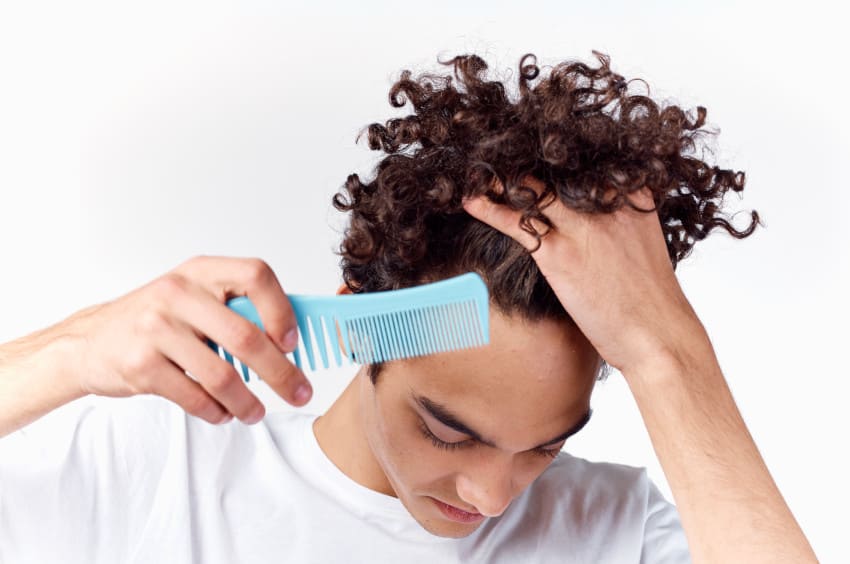
Curly Hair Transplants: Possible or Not?
If you are someone with curly hair, you may already be aware that your hair follicles are shaped differently to those with straight or wavy hair. Due to this, curly hair alopecia can sometimes have different causes and involve other factors when compared to alopecia in those with other hair types. You may be wondering if treatment options are different too, and if a hair transplant is possible for you and your specific hair type.
Hair loss of any kind can be distressing. Thankfully, modern medical treatments allow for restoration options regardless of hair type, gender, or age. In this article, we’ll be exploring the causes of curly hair loss and how it can be treated.
Types of Curly Hair Alopecia
There are two main types of curly hair loss conditions:
- Traction Alopecia: This type of alopecia is caused by excessive pulling or tension on the hair. It is common in people with curly hair who wear tight hairstyles, such as braids, cornrows, or ponytails.
- Androgenetic Alopecia: Also known as Male Pattern Baldness, or Female Pattern Baldness/Hair Loss, this is a hereditary condition that causes chronic, irreversible hair loss over time. It can occur in people of all hair types, genders, and ethnicities.
Causes: Breaking Down the Curl
Hair loss comes in many forms with a variety of different causes, so it’s important to speak to your doctor to determine the underlying condition before seeking any treatment. Genetics play a huge role in alopecia, however, so if your parents or grandparents have experienced curly hair alopecia, you are more likely to develop it yourself. Here are some of the most common causes of curly hair loss:
| Trigger | Effect |
| Hormones | Testosterone is a common cause of hair loss in both men and women. |
| Stress | When you are stressed, your body releases cortisol. This can harm your hair follicles, creating a cycle of hair loss and more stress, exacerbating the issue. |
| Medical Conditions | Some medical conditions, such as thyroid problems and autoimmune disorders, can cause hair loss. |
| Medications | Some medications, such as chemotherapy drugs, may cause hair loss as a side effect. |
| Hair Styling | Heat, commerical haircare products, and excessive styling can damage hair follicles over time, resulting in reduced follicle quality and,eventually, hair loss. |
Symptoms and Diagnosis: When to Intervene
Symptoms of curly hair alopecia can vary depending on the underlying cause. However, regardless of your condition, there are some signs that warrant attention. Here’s what to look out for:
- Hair loss in patches on the scalp
- Thinning hair or pattern hair loss
- Hair breakage, brittle strands, split ends, and overall poor quality hair
- Irritation of the scalp
If you are experiencing any or all of the above, we recommend that you speak with your doctor and pursue a diagnosis. Through careful examination of the scalp and hair, blood tests and/or scalp biopsies (if necessary), your medical practioner should be able to determine the cause of your hair loss and develop a treatment plan for you.
Treatments: Understanding Solutions & Risks

At Elithair, it is our goal to inform anyone suffering from curly hair alopecia of all the possible treatment options, so you can make an informed decision on how to address your condition. While considering the options outlined below, keep in mind that the ideal treatment depends on your specific type of alopecia and the severity of your hair loss.
| Treatment | Advantages | Disadvantages |
| Minoxidil | Halts hair loss and encourages regrowth by stimulating hair follicles and enhancing blood flow to the scalp. | Can cause changes in the texture of hair, irritation or redness of the scalp, and accidental hair growth in other regions of the body. Some extreme effects include chest pain, sudden weight gain, swelling of hands or feet, and dizziness. |
| Finasteride | Serves as a shield against hair loss, promoting regrowth and prolonging the growth phase of hair follicles. | Possible side effects include reduced libido, erectile dysfunction, ejaculation issues (more likely with higher doses in men), and substantial complications for pregnant women. |
| Hair Transplant | An effective surgical option where healthy hair follicles are shifted from one scalp region to another, providing a permanent solution to most types of alopecia. | Hair transplants usually have minimal side effects. Curly or afro-hair transplants can be trickier for some surgeons due to the curled follicles, making it harder to extract hair grafts. Temporary swelling and scarring might occur but often fades in a few weeks. |
| Light Therapy | Invigorates hair growth and stimulates hair follicles. | There is still no concrete data on the effectiveness of light therapy and more research required to figure out long/short term side effects. |
| Microneedling | Triggers the scalp’s natural healing response through microscopic punctures, often combined with treatments like minoxidil. | Redness, pain, swelling or some bruising may occur. |
| PRP Therapy (Vampire Lifting Method) | The patient’s own blood is taken and its plasma extracted via centrifuge. The plasma is then injected into balding areas, introducing growth factors and stimulating hair regrowth | Some minor swelling or injury to nerves can occur, but most research indicates this procedure is mostly safe without any substantial side effects. |
More About Hair Transplants: The Only Permanent Solution
If you’ve been struggling with persistent hair loss that returns after, or despite, a course of non-surgical treatment, it might be time to consider a hair transplant. Hair transplant surgery offers a lasting solution to chronic hair loss, but early intervention is vital. To learn if you’re a good candidate for surgery, speak to your doctor.
For a hair surgery, you need two things: enough healthy hair on your scalp to move to the recipient area, and the ability to grow hair in that area. One treatment is often enough to achieve the desired results. Curly hair transplants take 4–9 hours, depending on the grafts needed and the size of the recipient area. Extensive hair loss may require more than one treatment to address the severity of the hair loss.
If you’d like to understand the full procedure in detail — including how to prepare, recovery timelines, and travel options for an affordable and high-quality surgery — read our Hair Transplant Turkey Guide.
Other Criteria for a Hair Transplant
At Elithair, we understand your hair concerns and want to help. Unfortunately, we cannot provide care for adolescents, as their hormones have yet to balance, which can greatly effect their hair growth.
Additionally, hair transplants are not recommended for conditions like alopecia areata until the condition clears. In the case of alopecia areata, we recommend first treating the underlying cause with guidance from your doctor.
Navigating Challenges with Expertise
A large number of people across the globe have naturally curly hair. Most of the symptoms and types of hair loss outlined above are the same as those experienced by people with straight hair, with the distinction lying only in the approach to treatment.
Several treatments exist to tackle curly hair alopecia, but hair transplant surgeries are the only permanent solutions. That said, it is important to weigh all the costs and benefits before deciding on a treatment option that is right for you.
You might think it wise to err on the side of caution if there is a history of hair loss in your family, and to take preventative measures. While it’s certainly something worth discussing with your doctor, try to avoid panicking in advance as stress can exacerbate hair damage and have a negative imapct on your mental well-being.
If your condition persists, think about hair transplant procedures. With our budget-friendly rates, it’s a viable option for those who value their hair health and appearance. We’re here to answer your questions at every step of the process.
FAQ
What special considerations are there for curly hair transplants compared to straight hair transplants?
Curly hair transplants require careful handling of grafts to maintain the natural curl pattern. Surgeons must account for the unique growth angle and curvature of curly hair follicles.
How does the recovery process differ for individuals with curly hair?
Recovery is similar to other hair types, but individuals with curly hair might experience slightly more swelling or tightness due to the density and texture of their hair.
Can a curly hair transplant create a natural-looking hairline?
Yes, skilled hair surgeons can design a natural-looking hairline by strategically placing grafts to mimic the natural curl pattern and density.
Are there specific post-transplant care tips for curly hair?
Post-transplant care for curly hair includes using gentle, sulfate-free shampoos, avoiding tight hairstyles, and following a moisturising regimen to keep the hair and scalp healthy.
What is the success rate of curly hair transplants?
The success rate is high when performed by experienced surgeons. Proper technique ensures the survival of transplanted follicles and the preservation of the natural curl pattern.
How long does it take to see results after a curly hair transplant?
Initial growth can be seen within 3-4 months, with significant results visible at around 9-12 months. Full results typically take 12-18 months to manifest.
Are there any unique risks associated with curly hair transplants?
Unique risks include potential difficulty in extracting grafts without damaging the curl structure and ensuring the correct placement to maintain natural curl orientation.


